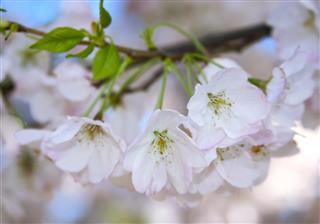
The most significant sign of the onset of spring is the cherry tree. There are many sub-species of this tree. To learn about the physical and biological characteristics of each of them, read on …
Flowering cherry trees (Prunus serrulata) are basically native to Japan, and hence, they are also called Japanese flowering cherry. Nowadays, they are found everywhere. The trees are so beautiful that during the blossom, they can beautify the entire area. They are mostly grown for their ornamental value. After a long winter, it is an amazing sight to see these trees blossom and transform into something so beautiful. Every year, many tourists from all over U.S., come to witness the spectacular event of the Cherry Blossom Festival, in Oregon and Washington D.C. Some popular types of flowering cherry trees are as follows.
Yoshino: This tree has white to pale pink flowers. It is a star attraction of the Cherry Blossom Festival. It is a fast-growing tree and can quickly attain a height of 20 feet; but it is also very short-lived. The tree has an oriental branching pattern, beautiful glossy bark and dark green leaves. It needs direct exposure to sunlight, for more than 6 hours a day, and well-drained soil for its proper growth.
Okame: This tree is a hybrid of Prunus incisa and Prunus campanulata. It is one of the most delicate and beautiful trees in this family. It is also one of the earliest to bloom, during spring. This deciduous tree can be distinguished by its shiny pink flowers, that grow in clusters of 2-5. In the fall, the tree is very beautiful because of its orange red leaves. The bark stands out with a bright, reddish-brown color. Thus, it can be used as an ornamental tree for the whole year. At maturity, it can attain a height of 20-30 feet. It can easily adapt to any soil and environment.
Weeping Cherry Tree: This latest and most popular kind has big, white flowers which cover the entire tree, so they are also known as ‘snow fountains’. The features that distinguish this one from others, are its willow branches that sweep with the wind. At maturity, they even touch the ground. They have a circumference of about 20-40 feet. It needs extra care, as it is prone to diseases and fungal infection. It also needs full sunlight exposure and moist soils for its overall growth. This tree does not grow in a cold environment.
Kwanzan: The Kwanzan cherry, named after a mountain in Japan, has pink flowers. It has double blossom as compared to any other tree, but is unable to bear any fruit. Even during the fall, it makes a striking view because of its golden leaves. Full sun exposure, loose and wet soil is highly recommended for its growth. It is intolerant to poor drainage. Transplantation of these trees is very easy.
Amanogawa: The flowers of this tree can range from white to pink, they are very fragrant and single or semi-double blossomed. This small tree has a circumference of 4-5 feet. It has small black fruits and has a very beautiful, reddish-copper bark. Its leaves are long, dark-green, which turn yellow in the fall. This tree requires full sun exposure and moist soil to grow.
Autumn Flowering Cherry Tree: This tree is the most unique of all. Not only does it bloom in spring, but also in the fall and winters. So, when other trees are shedding leaves, you have this striking, white tree in your garden. It has classic white, semi-double flowers. Unlike normal flowers with 5 petals; this one has 10 petals and bears small, black berries. The leaves are dark-green that change to yellow-copper before fall. The tree is the easiest to grow, since it can grow almost anywhere and everywhere.
There are also many varieties like Whitcomb cherry, Accolade cherry, Shirotae cherry, etc. These trees make your yards look beautiful; not only during the spring season, but throughout the year. Perhaps, this is the quality which makes them so popular.






